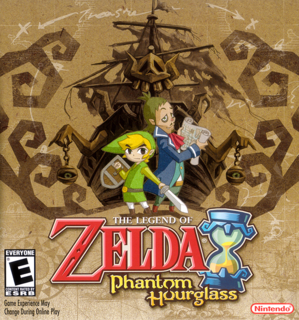Continuing my trend of playing games several years late, I recently took it upon myself to dig out The Legend of Zelda: Phantom Hourglass. This title is something of a rarity in the Zelda universe, being one of the few direct sequels ever made by Nintendo. The Legend of Zelda: Wind Waker was an awesome game back when it first released on the Gamecube, so I was curious to see how Phantom Hourglass would stack up when I finally decided to give it a go.
I came away from the experience with mixed feelings.
Phantom Hourglass hits a lot of the right notes. Considering the DS’s capability, the game looks great. Wind Waker’s cel-shaded style feels right at home on the DS screen. I’d even go so far as to say it’s one of the best looking DS games out there, despite releasing relatively early in the handheld’s lifespan. The action on-screen was always clear, and it’s obvious that Nintendo put a lot of time into making sure the look of the game carried the spirit of its predecessor.
The control scheme also deserves compliment. Going in, I honestly wasn’t sure how I’d feel about the all-stylus controls (yes, you can play the entire game without pushing a single button), but for the most part, they worked quite well. I won’t say it goes without hitches, however. Movement is smooth; all you need to do is have Link follow your stylus across the screen. Slashing with a sword is the same; just several quick swipes and you’re in business. Sadly, this limits the swordplay to only a few different slash types, but I suppose it never hindered combat either. It’s when you’re attempting to perform more specific strokes that the touch controls become irritating. Certain portions and battles in the game will have you drawing specific shapes in order to move forward. It’s a neat idea in theory, but it also creates some of the most frustrating moments in the game, as it often requires an extremely specific motion in order for the game to recognize that you’re drawing the proper shape. It’s usually not a problem with puzzles; it’s easy enough to redraw them a few times in order to fix it, but it can be extremely frustrating in battle when little drawing nuances lead to your demise. These issues aside, however, the stylus controls of the game are very well done. I’ve played plenty of DS games, and only one or two others come to mind even now that come close to utilizing the stylus as effectively as Phantom Hourglass did.
If the controls alone were the issue, I think I would have enjoyed this game much more than I did. Much more tiresome, however, was the repetition. Phantom Hourglass is a lovely game, make no mistake, but even a nice looking dungeon on the DS can get boring after you’ve visited it four or five times. So it is with the Temple of the Ocean King, that by the time I was halfway through the game, I often felt like what I was playing was a chore rather than a game for fun. As you unlock new items in Phantom Hourglass, it does get easier to traverse already beaten floors of the temple, but having to repeatedly go through them only became less fun as the game went on regardless. Eventually, players earn the right to skip several floors, but this means we’re still forced to play the floors after the halfway point a couple more times before the game has reached its conclusion.
The repetition becomes worse with the help of Phantom Hourglass’s soundtrack. There are a few good tunes, mind you. The main theme is a remix of Wind Waker’s, and while it doesn’t give you quite the same soaring sensation, it’s still a delight to listen to. There are also a few great melodies playing during a very climactic finish. Unfortunately, there are also a few simplistic songs that you’ll hear again… and again… and again. For many villages and dungeons you explore, the same two or three songs are used throughout the entire game. Unfortunately, I found the songs to be unexciting the first time I heard them, so by the time they came on in a third and fourth area, I was ready to throw my DS out the window.
…Okay, I wouldn’t go that far, but they really did get tiring.
Unfortunately, this sense of repetition from game location and music overshadowed much of my play through. Like I said before, Phantom Hourglass knocked it out of the park in several ways. It looks good and plays well, but in a way, it failed for me where it mattered most. After awhile, I stopped having fun. I lost the sense of excitement visiting a new area in a game should evoke. Sure, the areas looked different, but a lot of factors all work together to create a different sensation in each area of a game, with music and appearance making up a big part of that. Keeping all this in mind, it’s a difficult title for me to recommend to people who aren’t already fans of the series, as there are plenty of better entry points. Phantom Hourglass is a decent game, but there are much better Zelda titles out there.

